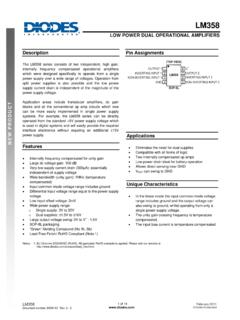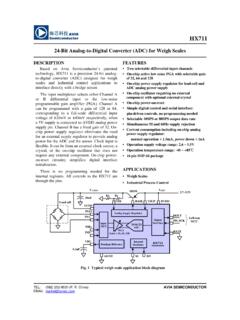Transcription of Op Amps for Everyone Design Guide (Rev. B)
1 DesignReferenceAdvanced Analog ProductsAugust 2002 SLOD006 BIMPORTANT NOTICET exas Instruments Incorporated and its subsidiaries (TI) reserve the right to make corrections,modifications, enhancements, improvements, and other changes to its products and services atany time and to discontinue any product or service without notice. Customers should obtain thelatest relevant information before placing orders and should verify that such information is currentand complete. All products are sold subject to TI s terms and conditions of sale supplied at thetime of order warrants performance of its hardware products to the specifications applicable at the time ofsale in accordance with TI s standard warranty. Testing and other quality control techniques areused to the extent TI deems necessary to support this warranty. Except where mandated bygovernment requirements, testing of all parameters of each product is not necessarily assumes no liability for applications assistance or customer product Design .
2 Customers areresponsible for their products and applications using TI components. To minimize the risksassociated with customer products and applications, customers should provide adequate designand operating does not warrant or represent that any license, either express or implied, is granted under anyTI patent right, copyright, mask work right, or other TI intellectual property right relating to anycombination, machine, or process in which TI products or services are used. Informationpublished by TI regarding third party products or services does not constitute a license from TIto use such products or services or a warranty or endorsement thereof. Use of such informationmay require a license from a third party under the patents or other intellectual property of that thirdparty, or a license from TI under the patents or other intellectual property of of information in TI data books or data sheets is permissible only if reproductionis without alteration and is accompanied by all associated warranties, conditions, limitations, andnotices.
3 Reproduction of this information with alteration is an unfair and deceptive businesspractice. TI is not responsible or liable for such altered of TI products or services with statements different from or beyond the parameters statedby TI for that product or service voids all express and any implied warranties for the associatedTI product or service and is an unfair and deceptive business practice. TI is not responsible orliable for any such Address:Texas InstrumentsPost Office Box 655303 Dallas, Texas 75265 Copyright 2002, Texas Instruments IncorporatediForwardEveryone interested in analog electronics should find some value in this book, and an ef-fort has been made to make the material understandable to the relative novice while nottoo boring for the practicing engineer. Special effort has been taken to ensure that eachchapter can stand alone for the reader with the proper background. Of course, this causesredundancy that some people might find boring, but it s worth the price to enable the satis-faction of a diversified at Chapter 1 if you are a novice, and read through until completion of Chapter 9.
4 AfterChapter 9 is completed, the reader can jump to any chapter and be confident that theyare prepared for the material. More experienced people such as electronic technicians,digital engineers, and non-electronic engineers can start at Chapter 3 and read throughChapter 9. Senior electronic technicians, electronic engineers, and fledgling analog engi-neers can start anywhere they feel comfortable and read through Chapter 9. Experiencedanalog engineers should jump to the subject that interests them. Analog gurus shouldsend their additions, corrections, and complaints to me, and if they see something thatlooks familiar, they should feel complimented that others appreciate their 1 is a history and story chapter. It is not required reading for anyone, but it definesthe op amp s place in the world of analog electronics. Chapter 2 reviews some basic phys-ics and develops the fundamental circuit equations that are used throughout the equations have been developed in other books, but the presentation here empha-sizes material required for speedy op amp Design .
5 The ideal op amp equations are devel-oped in Chapter 3, and this chapter enables the reader to rapidly compute op amp transferequations including ac response. The emphasis on single power supply systems forcesthe designer to bias circuits when the inputs are referenced to ground, and Chapter 4gives a detailed procedure that quickly yields a working solution every amps can t exist without feedback, and feedback has inherent stability problems,so feedback and stability are covered in Chapter 5. Chapters 6 and 7 develop the voltagefeedback op amp equations, and they teach the concept of relative stability and com-pensation of potentially unstable op amps. Chapter 8 develops the current feedback opamp equations and discusses current feedback stability. Chapter 9 compares currentfeedback and voltage feedback op amps. The meat of this book is Chapters 12, 13, and14 where the reader is shown how Design the converter to transducer /actuator interfacewith the aid of op remaining chapters give support material for Chapters 12, 13, and 14.
6 Chapter 18was a late addition. Portable applications are expanding rapidly and they emphasize theneed for low- voltage /low-power Design techniques. Chapter 18 defines some parametersin a new way so they lend themselves to low voltage Design , and it takes the readerthrough several low voltage Thanks to editor James Karki for his contribution. We never gave him enough time to dodetailed editing, so if you find errors or typos, direct them to my attention. Thanks to TedThomas, a marketing manager with courage enough to support a book, and big thanksfor Alun Roberts who paid for this effort. Thomas Kugelstadt, applications manager,thanks for your support and many thanks to the contributing authors, James Karki, Richard Palmer, Thomas Ku-gelstadt, Perry Miller, Bruce Carter, and Richard Cesari who gave generously of their ,Ron ManciniChief EditorContentsiiiContents1 The op amp s Place In The World1-1.. 2 Review of Circuit Theory2-1.. of Physics2-1.
7 Divider Rule2-3.. Divider Rule2-4.. s Theorem2-5.. of a Saturated Transistor Circuit2-9.. Amplifier2-10.. 3 Development of the Ideal op amp Equations3-1.. op amp Assumptions3-1.. Noninverting Op Amp3-3.. Inverting Op Amp3-4.. Adder3-5.. Differential Amplifier3-6.. Feedback Networks3-7.. Amplifiers3-9.. 4 Single Supply op amp Design Techniques4-1.. Supply versus Dual Supply4-1.. Analysis4-3.. Equations4-8.. 1: VOUT = +mVIN+b4-9.. 2: VOUT = +mVIN b4-13.. 3: VOUT = mVIN + b4-16.. 4: VOUT = mVIN b4-19.. 5 Feedback and Stability Theory5-1.. Study Feedback Theory?5-1.. Diagram Math and Manipulations5-1.. Equation and Stability5-6.. Contentsiv Analysis of Feedback Circuits5-7.. Gain Plots are the Key to Understanding Stability5-12.. Second Order Equation and Ringing/Overshoot Predictions5-15.. 6 Development of the Non Ideal op amp Equations6-1.. of the Canonical Equations6-2.. Op Amps6-5.. Op Amps6-6.. Op Amps6-8.
8 7 voltage -Feedback op amp Compensation7-1.. Compensation7-2.. Compensation, Stability, and Performance7-8.. Compensation7-9.. Compensation7-12.. Compensation7-13.. Attenuator Applied to Op Amp7-16.. Compensation7-18.. of Compensation Schemes7-20.. Conclusions7-21.. 8 current -Feedback op amp Analysis8-1.. Model8-1.. of the Stability Equation8-2.. Noninverting CFA8-3.. Inverting CFA8-5.. Analysis8-7.. of the Feedback Resistor8-9.. and Input Capacitance8-11.. and Feedback Capacitance8-12.. Compensation of CF and CG8-13.. 9 voltage - and current -Feedback op amp Comparison9-1.. Comparison9-8.. ContentsvContents10 op amp Noise Theory and Applications10-1.. Introduction10-1.. Characterization10-1.. rms versus P-P Noise10-1.. Noise Floor10-3.. Signal-to-Noise Ratio10-3.. Multiple Noise Sources10-3.. Noise Units10-4.. Types of Noise10-4.. Shot Noise10-5.. Thermal Noise10-7.. Flicker Noise10-8.
9 Burst Noise10-9.. Avalanche Noise10-9.. Noise Colors10-10.. White Noise10-11.. Pink Noise10-11.. Red/Brown Noise10-12.. op amp Noise10-12.. The Noise Corner Frequency and Total Noise10-12.. The Corner Frequency10-13.. op amp Circuit Noise Model10-14.. Inverting op amp Circuit Noise10-16.. Noninverting op amp Circuit Noise10-17.. Differential op amp Circuit Noise10-18.. Summary10-18.. Putting It All Together10-19.. References10-23.. 11 Understanding op amp Parameters11-1.. Amplifier Parameter Glossary11-2.. Parameter Information11-8.. Input Offset Voltage11-8.. Input Current11-10.. Input Common Mode voltage Range11-11.. Differential Input voltage Range11-11.. Maximum Output voltage Swing11-12.. Large Signal Differential voltage Amplification11-13.. Input Parasitic Elements11-13.. Output Impedance11-14.. Common-Mode Rejection Ratio11-15.. Supply voltage Rejection Ratio11-15.
10 Supply Current11-16.. Contentsvi Slew Rate at Unity Gain11-16.. Equivalent Input Noise11-17.. Total Harmonic Distortion Plus Noise11-18.. Unity Gain Bandwidth and Phase Margin11-19.. Settling Time11-22.. 12 Instrumentation: Sensors to A/D Converters12-1.. Introduction12-1.. transducer Types12-6.. Design Procedure12-11.. Review of the System Specifications12-12.. Reference voltage Characterization12-12.. transducer Characterization12-13.. ADC Characterization12-15.. op amp Selection12-15.. Amplifier Circuit Design12-16.. Test12-23.. Summary12-23.. References12-23.. 13 Wireless Communication: Signal Conditioning for IF Sampling13-1.. Introduction13-1.. Wireless Systems13-1.. Selection of ADCs/DACs13-6.. Factors Influencing the Choice of Op Amps13-10.. Anti-Aliasing Filters13-11.. Communication D/A Converter Reconstruction Filter13-13.. External Vref Circuits for ADCs/DACs13-15.
















